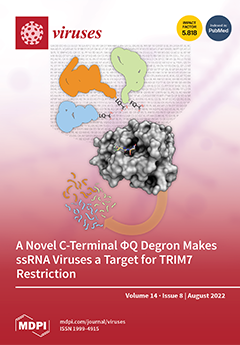The application of microbe-derived products as natural biocontrol agents to boost systemic disease resistance to virus infections in plants is a prospective strategy to make agriculture more sustainable and environmentally friendly. In the current study, the rhizobacterium
Bacillus amyloliquefaciens strain TBorg1 was identified
[...] Read more.
The application of microbe-derived products as natural biocontrol agents to boost systemic disease resistance to virus infections in plants is a prospective strategy to make agriculture more sustainable and environmentally friendly. In the current study, the rhizobacterium
Bacillus amyloliquefaciens strain TBorg1 was identified based on
16S rRNA,
rpoB, and
gyrA gene sequences, and evaluated for its efficiency in conferring protection of tomato from infection by
Tobacco mosaic virus (TMV). Under greenhouse circumstances, foliar sprays of TBorg1 culture filtrate (TBorg1-CF) promoted tomato growth, lowered disease severity, and significantly decreased TMV accumulation in systemically infected leaves of treated plants relative to untreated controls. TMV accumulation was reduced by 90% following the dual treatment, applied 24 h before and after TMV infection. Significant increases in levels of total soluble carbohydrates, proteins, and ascorbic acid were also found. In addition, a significant rise in activities of enzymes capable of scavenging reactive oxygen species (PPO and POX), as well as decreased levels of non-enzymatic oxidative stress markers (H
2O
2 and MDA) were observed, compared to untreated plants. Enhanced systemic resistance to TMV was indicated by significantly increased transcript accumulation of polyphenolic pathway (
C4H,
HCT, and
CHI) and pathogenesis-related (
PR-1 and
PR-5) genes. Out of the 15 compounds identified in the GC-MS analysis, 1,2-benzenedicarboxylic acid mono(2-ethylhexyl) ester and phenol, 2,4-bis(1,1-dimethylethyl), as well as L-proline, N-valeryl-, and heptadecyl ester were present in the highest concentrations in the ethyl acetate extract of TBorg1-CF. In addition, significant amounts of n-hexadecanoic acid, pyrrolo [1,2-a] pyrazine-1,4-dione hexahydro-3-(2-methylpropyl)-, nonane, 5-butyl-, and eicosane were also detected. These compounds may act as inducers of systemic resistance to viral infection. Our findings indicate that the newly isolated
B. amyloliquefaciens strain TBorg1 could be a potentially useful rhizobacterium for promoting plant growth and a possible source of biocontrol agents for combating plant virus infections.
Full article






